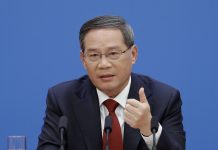BEIJING: The 2020 U.S. election, with a complex and controversial outcome, has seen the dust settle after months of farce and chaos with Joe Biden sworn in as the 46th U.S. president on January 20. However, party polarization still continues in the U.S. and more complicated confrontations between the Democrats and Republicans are anticipated in the future.
What will be the future of China-U.S. relations?
China and the U.S. both have their distinctive histories, cultures and values. They have different national systems and social governance and foreign relations policies.
In the past, they learned to cooperate after a period of confrontation.
After the founding of the People’s Republic of China in 1949, the U.S. followed a foreign policy with anti-communism and anti-socialism as its core concept, and carried out a total containment policy of political non-recognition, economic blockade and military encirclement against China. The two countries were in a state of bitter rivalry.
After the Korean War broke out in June 1950, its flames reached China’s border. The border regions in northeast China were repeatedly bombed by U.S. planes. At the request of the Democratic People’s Republic of Korea (DPRK), the Chinese People’s Volunteer Army entered the Korean Peninsula in October 1950 to aid the DPRK in the three-year fight until a truce was reached in 1953. The U.S. also obstructed the restoration of China’s lawful seat in the United Nations and was responsible for the confrontation between the two nations at that time.
In the late 1960s and early 1970s, strategic changes occurred in Asia and the rest of the world. Chairman Mao Zedong and Premier Zhou Enlai took the initiative to adjust China’s policy toward the West. Realizing China’s important role in international relations, then U.S. President Richard Nixon visited China in 1972 and the Shanghai Communique was issued, a key diplomatic document guiding the normalization of bilateral ties.
Chinese leader Deng Xiaoping and then U.S. President Jimmy Carter jointly promoted dialogues and negotiations leading to the establishment of diplomatic ties in 1979.
In 2013, President Xi Jinping proposed the concept of building a new model of major-country relationship between the two countries featuring non-conflict, non-confrontation, mutual respect and win-win cooperation. It served the common interests of both countries and conformed to the trend of the times.
By 2015, there were full-fledged mechanisms for political dialogue and consultation between the two, including the China-U.S. Strategic and Economic Dialogue and China-U.S. Political Party Leaders Dialogue.
In 2016, bilateral trade exceeded $500 billion with growing mutual investment and scientific and technological cooperation. The peoples of the two countries enjoyed the benefits and the international community too gained from the steady growth of China-U.S. relations.
– The Daily Mail-Beijing Review News exchange item





